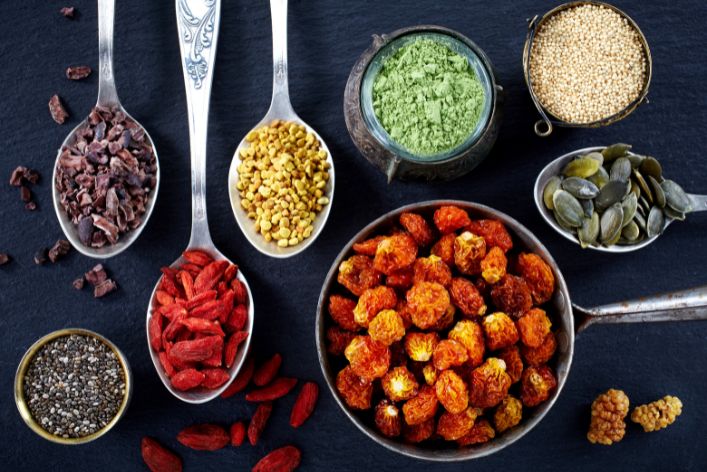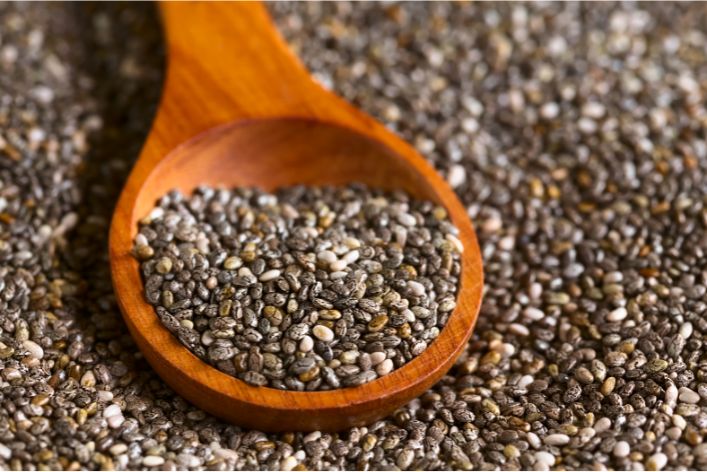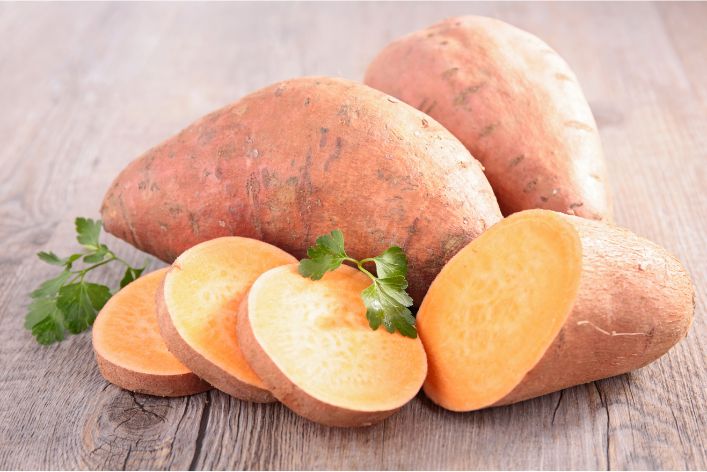Superfoods are nutrient-dense foods that are beneficial for your overall health and well-being. Incorporating superfoods into your diet can improve your energy levels, immune system, and cognitive function.

The purpose of this blog post is to provide a comprehensive list of the top 10 superfoods you should include in your diet, as well as tips on how to incorporate them into your daily meals.
A. Blueberries

Blueberries are a delicious and nutritious superfood that can be enjoyed in many ways. Here are some of the key nutritional benefits of blueberries:
1. Nutritional benefits
- Rich in antioxidants: Blueberries are packed with antioxidants, which can help protect your body against free radicals and reduce inflammation.
- High in fiber: Blueberries are an excellent source of dietary fiber, which is important for maintaining a healthy digestive system.
- Low in calories: Blueberries are a low-calorie food, making them a great option for those trying to maintain or lose weight.
- Rich in vitamins and minerals: Blueberries are a good source of vitamins C, K, and B6, as well as potassium and manganese.
2. Ways to consume Blueberries
Blueberries can be enjoyed in a variety of ways. Here are some of our favorite ways to incorporate blueberries into your diet:
- Blueberry smoothie: Blend fresh or frozen blueberries with almond milk, banana, and honey for a delicious and nutritious smoothie.
- Blueberry parfait: Layer Greek yogurt, granola, and fresh blueberries for a healthy and filling breakfast or snack.
- Blueberry salad: Toss fresh blueberries with mixed greens, sliced almonds, and goat cheese for a delicious and nutritious salad.
3. Tips for selecting fresh Blueberries
When selecting blueberries, look for berries that are plump, firm, and deep blue in color. Avoid berries that are soft, shriveled, or have signs of mold. Store blueberries in the refrigerator and rinse them thoroughly before consuming.
B. Kale

Kale is a nutrient-dense leafy green that has become increasingly popular in recent years. Here are some of the key nutritional benefits of kale:
1. Nutritional benefits
- High in vitamins and minerals: Kale is an excellent source of vitamins A, C, and K, as well as minerals such as calcium, potassium, and magnesium.
- Rich in antioxidants: Kale is packed with antioxidants, which can help protect your body against free radicals and reduce inflammation.
- High in fiber: Kale is a great source of dietary fiber, which is important for maintaining a healthy digestive system.
- Low in calories: Kale is a low-calorie food, making it a great option for those trying to maintain or lose weight.
2. Ways to consume Kale
Kale can be used in a variety of ways. Here are some of our favorite ways to incorporate kale into your diet:
- Kale salad: Toss chopped kale with a simple vinaigrette and top with your favorite toppings, such as sliced almonds, cherry tomatoes, and avocado.
- Kale chips: Bake kale leaves in the oven with a sprinkle of sea salt for a healthy and crunchy snack.
- Kale smoothie: Blend kale with frozen berries, almond milk, and honey for a delicious and nutritious smoothie.
3. Tips for selecting fresh Kale
When selecting kale, look for leaves that are deep green and firm. Avoid kale with yellow or brown spots, which may indicate that it’s past its prime. Store kale in the refrigerator and rinse it thoroughly before consuming.
Read: What Are Fibre-Rich Foods?
C. Salmon

Salmon is a delicious and nutritious superfood that is rich in omega-3 fatty acids. Here are some of the key nutritional benefits of salmon:
1. Nutritional benefits
- Rich in omega-3 fatty acids: Salmon is an excellent source of omega-3 fatty acids, which are important for heart health and brain function.
- High in protein: Salmon is a great source of high-quality protein, which is important for building and maintaining muscle.
- Rich in vitamins and minerals: Salmon is a good source of vitamins B12 and D, as well as minerals such as selenium and potassium.
2. Ways to consume Salmon
Salmon can be prepared in a variety of ways. Here are some of our favorite ways to incorporate salmon into your diet:
- Baked salmon: Season salmon fillets with lemon, garlic, and herbs and bake in the oven for a healthy and flavorful meal.
- Grilled salmon: Brush salmon with olive oil and grill over high heat for a delicious and smoky flavor.
- Salmon salad: Flake cooked salmon over mixed greens and top with your favorite vegetables and a simple vinaigrette.
3. Tips for selecting fresh Salmon
When selecting salmon, look for fillets that are firm and bright in color. Avoid salmon that has a strong fishy odor or looks slimy. It’s also important to choose wild-caught salmon over farmed salmon, as wild-caught salmon is generally higher in nutrients and lower in contaminants. Store salmon in the refrigerator and cook it within a few days of purchase.
D. Quinoa

Quinoa is a gluten-free superfood that is high in protein and essential nutrients. Here are some of the key nutritional benefits of quinoa:
1. Nutritional benefits
- High in protein: Quinoa is a complete protein, meaning it contains all nine essential amino acids, making it an excellent source of protein for vegetarians and vegans.
- Rich in fiber: Quinoa is high in both soluble and insoluble fiber, which is important for maintaining a healthy digestive system.
- Contains healthy fats: Quinoa contains heart-healthy fats, such as omega-3 and omega-6 fatty acids.
- High in vitamins and minerals: Quinoa is an excellent source of vitamins and minerals, including iron, magnesium, potassium, and zinc.
2. Ways to consume Quinoa
Quinoa is incredibly versatile and can be used in a variety of ways. Here are some of our favorite ways to incorporate quinoa into your diet:
- Quinoa salad: Mix cooked quinoa with your favorite vegetables, such as cherry tomatoes, cucumbers, and red onion, and toss with a simple vinaigrette.
- Quinoa bowl: Top cooked quinoa with roasted vegetables, grilled chicken or tofu, and a drizzle of your favorite sauce.
- Quinoa breakfast bowl: Top cooked quinoa with sliced banana, chopped nuts, and a drizzle of honey for a healthy and filling breakfast.
3. Tips for selecting fresh Quinoa
When buying quinoa, choose packages labeled with a “best by” date and tightly sealed to ensure freshness. It’s also important to rinse quinoa thoroughly before cooking to remove any bitterness. To cook quinoa, simmer one cup of quinoa with two cups of water or broth for 15-20 minutes until fully absorbed.
Innovative Tech Solutions, Tailored for You
Our leading tech firm crafts custom software, web & mobile apps, designed with your unique needs in mind. Elevate your business with cutting-edge solutions no one else can offer.
Start NowE. Avocado

Avocado is a superfood that is packed with heart-healthy fats and essential nutrients. Here are some of the key nutritional benefits of avocado:
1. Nutritional benefits
- Heart-healthy fats: Avocado is high in monounsaturated and polyunsaturated fats, which can help reduce inflammation and lower cholesterol levels.
- High in fiber: Avocado is an excellent source of dietary fiber, which is important for maintaining a healthy digestive system.
- Rich in vitamins and minerals: Avocado is a good source of vitamins C, E, K, and B6, as well as potassium and folate.
2. Ways to consume Avocado
There are countless ways to enjoy avocado. Here are some of our favorite ways to incorporate it into your diet:
- Avocado toast: Mash ripe avocado onto whole-grain toast and top with a sprinkle of sea salt and black pepper.
- Guacamole: Mix mashed avocado with diced tomatoes, red onion, cilantro, and lime juice for a delicious and healthy dip.
- Avocado smoothie: Blend ripe avocado with almond milk, banana, and honey for a creamy and nutritious smoothie.
3. Tips for selecting fresh Avocado
When selecting avocados, look for ones that are firm but give slightly when pressed. You can also check the stem – if it comes off easily and is green underneath, the avocado is ripe and ready to eat. It’s important to store avocados at room temperature until they ripen, and then move them to the refrigerator to prevent them from over-ripening. If you only need half an avocado, keep the other half with the pit intact and wrap it tightly in plastic wrap to prevent browning.
Read: Is Junk Food Cheaper Than Healthy Food?
F. Chia seeds

Chia seeds are a tiny but mighty superfood that is packed with essential nutrients. Here are some of the key nutritional benefits of chia seeds:
1. Nutritional benefits
- High in fiber: Chia seeds are an excellent source of dietary fiber, which is important for maintaining a healthy digestive system.
- Rich in omega-3 fatty acids: Chia seeds are one of the best plant-based sources of omega-3 fatty acids, which are important for heart health and brain function.
- High in protein: Chia seeds are a good source of plant-based protein, making them an excellent option for vegetarians and vegans.
- Rich in vitamins and minerals: Chia seeds are a good source of several essential vitamins and minerals, including calcium, magnesium, and phosphorus.
2. Ways to consume Chia seeds
Chia seeds are incredibly versatile and can be used in a variety of ways. Here are some of our favorite ways to incorporate chia seeds into your diet:
- Chia pudding: Mix chia seeds with almond milk, honey, and vanilla extract and let sit in the refrigerator overnight for a healthy and filling breakfast or snack.
- Chia smoothie: Blend chia seeds with your favorite fruits and vegetables for a nutritious and energizing smoothie.
- Chia jam: Mix chia seeds with mashed berries and honey for a healthy and delicious spread.
3. Tips for selecting fresh Chia seeds
When choosing chia seeds, select tightly sealed packages labeled with a “best by” date. Store at room temperature for up to two years. When using chia seeds in recipes, be sure to soak them in liquid first to prevent them from clumping.
G. Sweet Potato

Sweet potatoes are a nutritious and versatile superfood that can be enjoyed in a variety of ways. Here are some of the key nutritional benefits of sweet potatoes:
1. Nutritional benefits
- Rich in vitamins and minerals: Sweet potatoes are an excellent source of vitamins A and C, as well as potassium and fiber.
- Low glycemic index: Sweet potatoes have a lower glycemic index than regular potatoes, which means they are less likely to cause a spike in blood sugar levels.
- Anti-inflammatory properties: Sweet potatoes are rich in antioxidants, which can help reduce inflammation in the body.
2. Ways to consume Sweet Potato
Sweet potatoes can be used in a variety of ways. Here are some of our favorite ways to incorporate sweet potatoes into your diet:
- Roasted sweet potato: Toss diced sweet potato with olive oil and spices and roast in the oven for a healthy and flavorful side dish.
- Sweet potato fries: Slice sweet potato into thin wedges and bake in the oven for a healthier version of traditional french fries.
- Sweet potato soup: Blend cooked sweet potato with chicken broth, coconut milk, and spices for a warming and nutritious soup.
3. Tips for selecting fresh Sweet Potato
When selecting sweet potatoes, look for ones that are firm and have smooth skin without any bruises or soft spots. Choose sweet potatoes with a deep orange color, which indicates that they are rich in beta-carotene. Store sweet potatoes in a cool, dry place, and avoid storing them in the refrigerator. Sweet potatoes can be stored for up to two weeks.
H. Spinach

Spinach is a nutrient-dense leafy green that is incredibly versatile and easy to incorporate into your diet. Here are some of the key nutritional benefits of spinach:
1. Nutritional benefits
- Rich in vitamins and minerals: Spinach is an excellent source of vitamins A, C, and K, as well as minerals such as iron and calcium.
- Low in calories: Spinach is a low-calorie food, making it a great option for those trying to maintain or lose weight.
- Rich in antioxidants: Spinach is packed with antioxidants, which can help protect your body against free radicals and reduce inflammation.
2. Ways to consume Spinach
Spinach can be used in a variety of ways. Here are some of our favorite ways to incorporate spinach into your diet:
- Spinach salad: Toss fresh spinach with sliced strawberries, crumbled feta cheese, and balsamic vinaigrette for a delicious and nutritious salad.
- Spinach smoothie: Blend spinach with frozen banana, almond milk, and peanut butter for a healthy and energizing smoothie.
- Spinach quiche: Combine chopped spinach with eggs, cheese, and spices for a tasty and protein-packed quiche.
3. Tips for selecting fresh Spinach
When selecting spinach, look for leaves that are bright green and firm. Avoid spinach that is yellow or wilted, as it may indicate that it is past its prime. Store spinach in the refrigerator and rinse it thoroughly before consuming. Spinach can be stored for up to a week in the refrigerator.
I. Garlic

Garlic is a flavorful superfood that is known for its powerful health benefits. Here are some of the key nutritional benefits of garlic:
1. Nutritional benefits
- Rich in antioxidants: Garlic is packed with antioxidants, which can help protect your body against free radicals and reduce inflammation.
- Anti-inflammatory properties: Garlic contains compounds that can help reduce inflammation in the body.
- May reduce the risk of heart disease: Garlic has been shown to help lower blood pressure and reduce the risk of heart disease.
2. Ways to consume Garlic
Garlic can be used in a variety of ways. Here are some of our favorite ways to incorporate garlic into your diet:
- Roasted garlic: Roast whole garlic bulbs in the oven for a delicious and savory spread.
- Garlic sautéed vegetables: Sauté vegetables such as broccoli or kale with minced garlic for a healthy and flavorful side dish.
- Garlic shrimp: Sauté shrimp with garlic and butter for a quick and easy protein-packed meal.
3. Tips for selecting fresh Garlic
When selecting garlic, look for bulbs that are firm and have tight, dry skin. Avoid garlic with soft spots or moldy spots. It’s best to store garlic in a cool, dark place such as a pantry or cupboard. Garlic can be stored for several months in a dry and well-ventilated area.
J. Ginger

Ginger is a flavorful and versatile superfood that is known for its numerous health benefits. Here are some of the key nutritional benefits of ginger:
1. Nutritional benefits
- Anti-inflammatory properties: Ginger contains compounds that can help reduce inflammation in the body.
- May reduce nausea and vomiting: Ginger has been shown to be effective in reducing nausea and vomiting, particularly during pregnancy or after surgery.
- May improve digestion: Ginger can help stimulate digestion and relieve digestive issues such as bloating and gas.
2. Ways to Consume Ginger
Ginger can be used in a variety of ways. Here are some of our favorite ways to incorporate ginger into your diet:
- Ginger tea: Steep sliced ginger in hot water for a soothing and healthy tea.
- Ginger stir-fry: Sauté sliced ginger with your favorite vegetables and protein for a healthy and flavorful meal.
- Ginger smoothie: Blend sliced ginger with your favorite fruits and vegetables for a nutritious and refreshing smoothie.
3. Tips for selecting fresh Ginger
When selecting ginger, look for pieces that are firm and free of wrinkles or soft spots. Choose ginger with smooth skin and a fresh, spicy aroma. Store ginger in the refrigerator or freezer to extend its shelf life. When using ginger, it’s best to peel it with a spoon or a vegetable peeler before slicing or grating.
How to incorporate Superfoods in your daily diet
Incorporating superfoods into your daily diet is easier than you might think. Here are some tips for adding superfoods to your meals and snacks:
A. Meal plan
Planning your meals ahead of time can help you incorporate more superfoods into your diet. Consider adding a variety of superfoods to your meals, such as quinoa, spinach, and salmon. Try to include at least one superfood in each meal to maximize your nutrient intake.
B. Recipe ideas
There are countless recipes that incorporate superfoods. Here are some recipe ideas to get you started:
- Quinoa and roasted sweet potato salad with spinach and avocado
- Garlic-roasted salmon with kale and sweet potato mash
- Chia seed pudding with blueberries and almonds
- Avocado and spinach smoothie with ginger and banana
C. Superfoods snacks
Snacks are a great way to incorporate superfoods into your diet. Here are some healthy and delicious snack ideas:
Seamless API Connectivity for Next-Level Integration
Unlock limitless possibilities by connecting your systems with a custom API built to perform flawlessly. Stand apart with our solutions that others simply can’t offer.
Get Started- Apple slices with almond butter and chia seeds
- Carrot sticks with hummus and sliced avocado
- Sweet potato chips with guacamole
- Blueberry and spinach smoothie bowl with granola and honey
By incorporating superfoods into your meals and snacks, you can boost your nutrient intake and support your overall health and well-being.
Conclusion
Incorporating superfoods into your diet can have numerous health benefits. Let’s recap the top 10 superfoods:
- Blueberries
- Kale
- Salmon
- Quinoa
- Avocado
- Chia seeds
- Sweet potato
- Spinach
- Garlic
- Ginger
By incorporating these superfoods into your meals and snacks, you can increase your nutrient intake and support your overall health.
It’s important to make an effort to incorporate superfoods into your diet. Whether you’re looking to improve your digestion, boost your immune system, or reduce inflammation, superfoods can help. So, start incorporating these nutrient-dense foods into your meals and snacks today.
We hope this blog post has inspired you to make healthy and nutritious choices. Don’t wait any longer, take action now and start reaping the benefits of superfoods!
Before You Go…
Hey, thank you for reading this blog to the end. I hope it was helpful. Let me tell you a little bit about Nicholas Idoko Technologies. We help businesses and companies build an online presence by developing web, mobile, desktop, and blockchain applications.
We also help aspiring software developers and programmers learn the skills they need to have a successful career. Take your first step to become a programming boss by joining our Learn To Code academy today!
Be sure to contact us if you need more information or have any questions! We are readily available.











